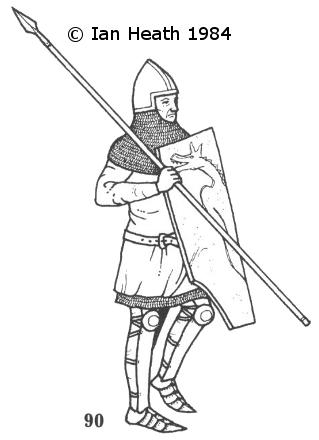
Try Amazon Audible Premium Plus and Get Up to Two Free Audiobooks
HUNGARIAN FOOT-SOLDIER c. 1380
An extract from Armies of the Middle Ages, Volume 2by Ian Heath



90. HUNGARIAN FOOT-SOLDIER c. 1380
Remarks such as Oman's that 'the Hungarians had no native foot-soldiery of their own' probably derive from the fact that cavalry predominated on the battlefield so dramatically that infantry rarely got a look-in when the chroniclers compiled their versions of events, and it is undeniable that before the large-scale employment of mercenary armies began in Hungary towards the middle of the 15th century infantry played a very secondary role in Hungarian warfare. Nevertheless, even Oman acknowledges that Schultberger records infantry amongst the Hungarian garrison put into Vidin by Sigismund en route to Nicopolis, and even though Froissart refers to the army containing 'but few afoot' in one place and being 'all on horseback' in another, it is significant that another chronicler, the Religieux de Saint-Denis, mentions '40,000' infantry as being present at the latter battle.
The figure portrayed here, from a church fresco, is undeniably an infantryman, and his armour marks him out as one of the wealthier jobbágy, who seem to have been armed with sword, shield and spear rather than bow and arrows. Armour was not a specific requirement of those performing militia service until the latter part of the 15th century, but doubtless those that could afford it wore it. This particular figure has a mail corselet and hood, plate armour for the fronts of his legs and feet, and a yellow pavise decorated with a non-heraldic dragon device.
In the 15th century Hungarian infantry were predominantly provided either by mercenaries (chiefly Bohemians, but also Germans, Italians and, after 1482, some Swiss), or else by Transylvanians, Wallachians and Moldavians. Many of the mercenaries were handgunners, as too were a sizeable proportion of the Transylvanians 2,000 of them in 1475/9 - the handgun having apparently come into common use in the Balkans in the 1420s, probably being introduced into Hungary in the hands of Italian mercenaries. By the time of the second battle of Kossovo in 1448 they were relatively widespread amongst Hunyadi's Transylvanian, German and Bohemian forces, one source referring to them having small, medium and large 'bombards which they call sciopietae'. The smallest weighed about 15 lbs, but the largest, called puschoni, could weigh up to 90 lbs or even 135 lbs. In 1480 King Matthias himself could write of Hungarian armies that 'we make it a rule that one-fifth of the infantry are arquebusiers', the other four-fifths being light and heavy infantry and pavise-bearers.